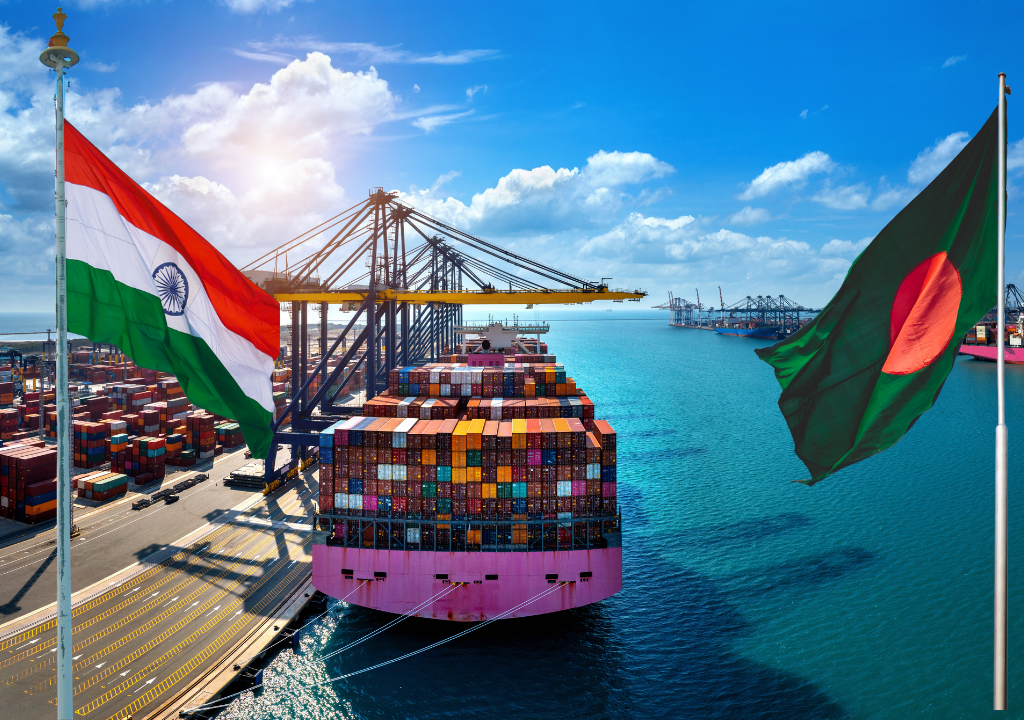Introduction
In a major move that could reshape India-Bangladesh trade flows and regional diplomacy, India has officially withdrawn the trans-shipment facility it had extended to Bangladesh since 2020. This facility allowed Bangladeshi exporters to transport goods to third countries such as Bhutan, Nepal, and Myanmar using Indian infrastructure—including roads, ports, and airports.
The cancellation of this facility in April 2025 represents a strategic pivot in India-Bangladesh relations, reflecting shifting priorities in trade, security, and regional influence. While the move is technical in nature, its geopolitical implications are significant.
What Was the India-Bangladesh Trans-Shipment Facility?
The trans-shipment facility was introduced as part of India’s Neighbourhood First policy. It was designed to promote regional connectivity by allowing Bangladesh to move export cargo through India to reach landlocked destinations like Bhutan and Nepal, as well as third countries through Indian ports and airports.
Under this arrangement:
-
Goods were transported from Bangladesh via Indian Land Customs Stations (LCSs)
-
These goods then moved to Indian ports such as Haldia or airports like Kolkata and Delhi
-
From there, shipments were exported to their final global destinations
For Bangladesh, especially its Ready-Made Garment (RMG) sector, the facility was a game-changer. It cut down logistics costs by up to 30%, improved delivery timelines, and boosted competitiveness in global markets.
The trans-shipment system became a symbol of economic interdependence, showing how India-Bangladesh relations were maturing beyond politics into tangible economic cooperation.
What Happened in April 2025?
On April 8, 2025, India’s Central Board of Indirect Taxes and Customs (CBIC) issued a circular formally revoking the trans-shipment facility. The next day, the Ministry of External Affairs (MEA) clarified the rationale behind the decision.
According to MEA spokesperson Randhir Jaiswal, the facility had begun to:
-
Cause congestion at Indian ports and airports
-
Delay India’s own export shipments
-
Create logistical inefficiencies that impacted Indian businesses
As of now, Bangladesh can still use Indian land routes to Nepal and Bhutan, but cannot access Indian seaports or airports for trans-shipment. This has dealt a major blow to Bangladesh’s global trade network, especially for time-sensitive RMG exports.

Why Did India Withdraw the Facility?
While the official justification focuses on logistical inefficiency, the decision reflects a mix of economic, infrastructural, and political concerns.
✦ 1. Port Congestion & Export Delays
India’s growing export volumes, especially through ports like Haldia and Mumbai, were reportedly affected by the additional Bangladeshi cargo load. Delays in container processing led to complaints from Indian exporters.
✦ 2. Infrastructure Strain
Indian customs infrastructure at border checkpoints like Petrapole and Phulbari faced capacity issues. With no corresponding investment from Bangladesh, Indian officials claimed the arrangement was becoming unsustainable.
✦ 3. Pressure from Indian Textile Lobby
Groups like the Apparel Export Promotion Council (AEPC) lobbied for the facility’s removal, citing unfair advantages given to Bangladeshi exporters. The RMG sector in Bangladesh is a direct competitor to India’s textile industry.
Links Suggested: India-Sri Lanka Relations : 5 Strategic Wins for Both Nations
Strategic Concerns and Geopolitical Tensions
Beyond logistics, India-Bangladesh relations have been influenced by recent geopolitical developments.
✦ Bangladesh’s Pivot to China
In early 2025, Bangladesh’s interim head Muhammad Yunus visited Beijing and made controversial remarks. He described India’s northeastern states as “landlocked” and positioned Bangladesh as a “gateway to the ocean.” This was seen in India as a provocative signal of shifting strategic loyalty.
✦ Chinese Investments in Lalmonirhat Airbase
Dhaka’s decision to invite Chinese investments to upgrade Lalmonirhat airbase, near India’s Siliguri Corridor, raised red flags in India-Bangladesh . The corridor is a narrow stretch that connects India to its northeastern states—making it a vital national security point.
These developments prompted India to view even trade facilitation through a security lens.
What’s Next for Bangladesh’s Export Strategy?
With the trans-shipment facility revoked, Bangladesh now faces logistical hurdles. Exporters must consider:
-
Longer routes through domestic ports such as Chittagong or Mongla
-
Higher reliance on third-country logistics partners, raising costs
-
Increased transit times to landlocked countries like Bhutan and Nepal
-
Difficulty competing with Vietnam and India in textile exports due to rising overheads
Small and medium enterprises in Bangladesh may find it difficult to absorb these shocks, affecting employment and foreign exchange earnings.
Links Suggested: China’s Debt Diplomacy in South Asia: 7 Uncovered Realities
Looking Ahead: Can the Facility Be Revived?
Despite the setback, there is room for diplomatic engagement. Indian officials have signaled that the India-Bangladesh Trans-Shipment Facility could be reconsidered if Bangladesh:
-
Addresses India’s security concerns
-
Promotes joint infrastructure development at border points
-
Reassures India on strategic neutrality in the Indo-Pacific region
-
Establishes mutual trade balance mechanisms
As of now, Indian diplomacy emphasizes “conditional cooperation” based on mutual trust and reciprocity.
Trade analysts also note that India may be using this moment to reset trade frameworks across South Asia, especially as China deepens its investments in infrastructure and defence across the region.
India’s actions indicate a shift toward realigning bilateral trade access with its geopolitical calculus. This may extend to other regional players like Myanmar and even Sri Lanka.
Conclusion
India’s decision to withdraw the trans-shipment facility extended to Bangladesh marks more than a shift in trade logistics—it reflects a recalibration of India-Bangladesh relations based on new strategic realities.
The move underscores how trade, diplomacy, and national security are increasingly intertwined in today’s multipolar world. While the immediate impact may be economic for Bangladesh, the long-term message is diplomatic: mutual trust must form the basis of regional cooperation.
As both nations evaluate their priorities, the possibility of renegotiating the facility remains. The coming months will be pivotal in determining whether this episode becomes a temporary disruption or a defining shift in India-Bangladesh relations.

